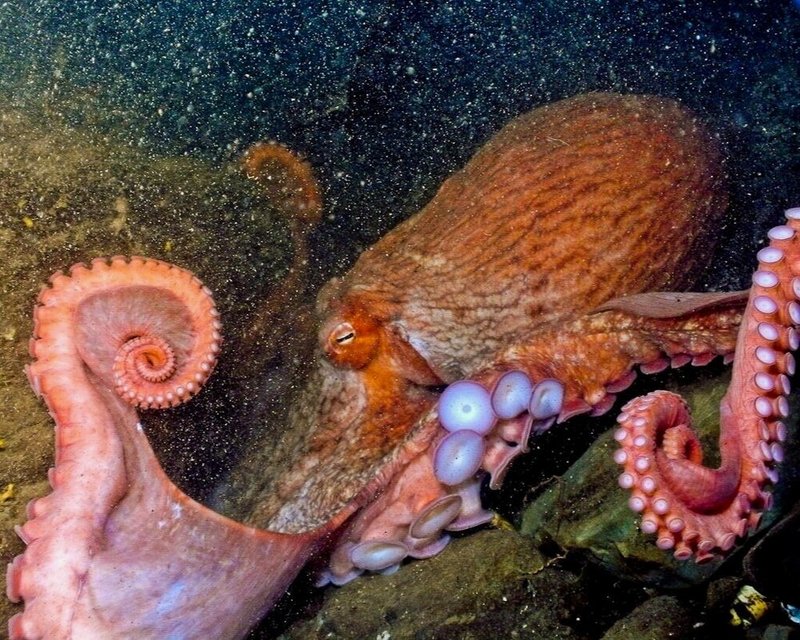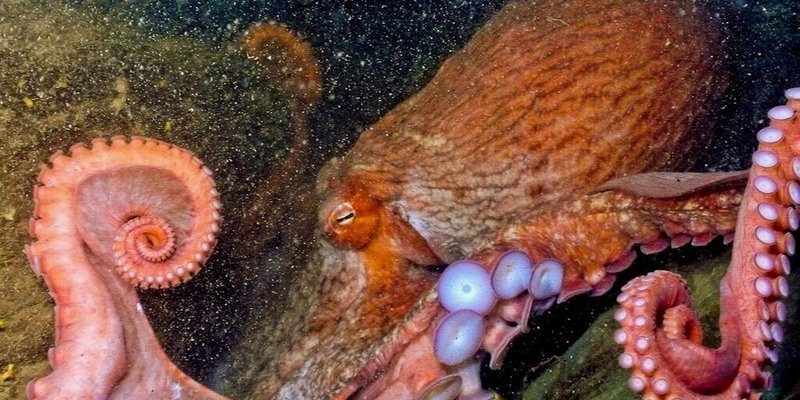
These intelligent beings are more than just brainy blobs of ink and tentacles. They have a fascinating life full of quirks and surprises. So, grab your favorite beverage as we dive into ten cool things you probably didn’t know about the Giant Pacific Octopus. You might find yourself a little more enchanted by these ocean dwellers by the end!
1. They Can Change Color and Texture
One of the most astounding features of the Giant Pacific Octopus is its ability to change color and texture. This talent isn’t just for show; it helps them blend into their surroundings to avoid predators. Think of them like nature’s very own chameleons, but with some extra flair.
Their skin contains special cells called chromatophores, which are filled with different pigments. When they want to change their appearance, they can expand or contract these cells, making them red, blue, or even mottled like a rock. This camouflage is so effective that you might easily miss one resting on the seafloor.
On top of that, they can alter their skin’s texture, too! They can go from smooth to spiky in a matter of seconds, which adds another layer of disguise. Imagine having the ability to not only blend in but also look like a jagged rock or a soft sponge. It’s pretty wild, right?
2. They Have Three Hearts
Here’s a fun fact: a Giant Pacific Octopus has three hearts! Two of these hearts pump blood to the gills, where the octopus gets oxygen. The third heart pumps the oxygen-rich blood to the rest of the body.
You might be wondering how this setup works. Well, when the octopus swims, the heart that pumps blood to the body actually stops beating, which is one reason they prefer to crawl rather than swim. Swimming takes a lot of energy, and these marvelous creatures are mostly bottom-dwellers.
Their blood is also pretty unique. It contains a copper-rich protein called hemocyanin instead of hemoglobin. This protein makes their blood blue, which is a pretty neat party trick if you ask me!
3. They’re Masters of Escape
Have you ever thought about being stuck somewhere and how you’d get out? For the Giant Pacific Octopus, escaping is part of their survival strategy. Their bodies are incredibly flexible and can squeeze through tight spaces, even if the opening is no larger than their beak—their only hard body part.
In fact, there are numerous stories of octopuses escaping from aquariums! One famous tale involves an octopus named Inky, who made a daring escape from the National Aquarium of New Zealand by slipping through a small gap in its tank and crawling across the floor to the ocean. Talk about a master escape artist!
Their intelligence plays a key role in these incredible feats. They can solve problems and even navigate through mazes. So, if you’re ever feeling trapped, channel your inner octopus!
4. They Have a Short Lifespan
Despite their impressive skills and intelligence, Giant Pacific Octopuses have a short lifespan—usually only three to five years. This might seem sad, but it’s just part of their natural life cycle.
Once they reach maturity, they focus on reproducing, which can be quite intense. The female will lay thousands of eggs and then devote herself entirely to caring for them. She doesn’t eat during this time and will eventually die after the eggs hatch. It’s a bittersweet ending, but it ensures the next generation has a fighting chance in the wild.
Interestingly, males also die shortly after mating. This cycle of life highlights the intense reproductive strategy these octopuses have evolved, ensuring their genes continue despite their brief time on Earth.
5. They Can Use Tools
When you think of tool use, you might picture humans or maybe some clever primates. But did you know the Giant Pacific Octopus can also use tools? Yes, they can! They’ve been observed using coconut shells and empty seashells as shelters or shields against predators.
In one remarkable study, researchers saw octopuses use discarded objects as weapons. They would pick up a shell, hold it over their heads, and use it to fend off attackers. This level of problem-solving ability shows just how smart these creatures really are.
Using tools isn’t common in all species, so when we see this behavior in octopuses, it’s exciting! It suggests a level of cognitive sophistication that’s still being explored by scientists today.
6. They Can Squirt Ink
When it comes to defense, the Giant Pacific Octopus has a classic trick up its sleeve: ink-squirting! If they feel threatened, they can release a cloud of ink to make a quick getaway. It’s like having an invisible shield that gives them just enough time to escape.
The ink is made up of a substance called melanin, which is what gives it its dark color. Interestingly, this ink can also act as a mild irritant to predators, making them think twice before chasing after an octopus.
But here’s the catch: they don’t use this tactic carelessly. If they’re in a safe spot, they may choose not to ink because it can also give away their location. It’s all about balance and survival!
7. They Have Unique Personalities
You might be surprised to learn that Giant Pacific Octopuses have distinct personalities. Some can be more adventurous, while others might prefer to hide away. This individuality is fascinating, especially considering their solitary nature.
Researchers have observed that some octopuses are naturally more curious and willing to explore new environments, while others might be shy and avoid interaction. This variation can change based on their environment and experiences, much like humans.
This personality trait plays into their intelligence, too. A more curious octopus may take the chance to explore a new object in their tank, while a shy one might simply wait and watch. This depth of character truly makes them captivating creatures to study and observe.
8. Their Eyes Are Amazing
Let’s talk about those big, beautiful eyes! The Giant Pacific Octopus has excellent vision, thanks to their large eyes that are similar in structure to human eyes. They can see well in low light conditions, making them proficient hunters even in the dark depths of the ocean.
Interestingly, they see in monochrome, which means they lack color vision. However, their eyes are incredibly sensitive to contrast and movement, which are crucial features for spotting prey and avoiding predators.
Moreover, their pupils can change shape from round to slit, allowing them to adjust their focus and depth perception. Imagine having the ability to change your vision depending on what you’re looking at—how cool is that?
9. They Have a Complex Brain
The Giant Pacific Octopus has a complex brain and nervous system that allows for impressive learning and memory. About two-thirds of their neurons are located in their arms, giving them a unique way to process information.
This means their arms can act independently, allowing them to feel and taste while they explore. It’s almost like having several mini-brains spread across their limbs, which is essential for their survival in the wild.
They can learn from their experiences, showing adaptability that is critical in the unpredictable underwater world. Whether it’s learning how to open a jar or remembering how to navigate through their environment, their brainpower is nothing short of remarkable.
10. They’re Ecologically Important
Finally, let’s highlight the important role the Giant Pacific Octopus plays in their ecosystem. As both predator and prey, they help maintain the balance in their underwater environment. They feed on crabs, fish, and other marine creatures, which keeps populations in check.
On the flip side, they’re also a food source for larger animals like sharks and sea lions. This interconnectedness is vital for marine health. Protecting these creatures is essential not only for their survival but also for the overall health of the ocean.
As habitats change and human activity impacts the oceans, understanding the role of the Giant Pacific Octopus in these ecosystems becomes even more crucial. They remind us of the delicate balance of life in our oceans and why we should work to preserve it.
In conclusion, the Giant Pacific Octopus is truly a marvel of the ocean. With their unique abilities, intelligence, and role in the ecosystem, they continue to intrigue scientists and casual observers alike. So, the next time you think about the creatures living in our oceans, remember the octopus—a creature that is surprisingly complex, smart, and full of surprises.

